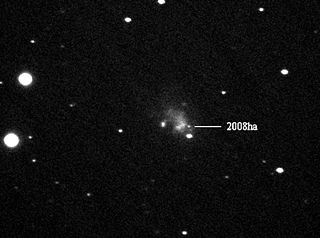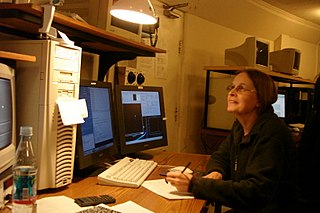Related Research Articles

SN 1987A was a type II supernova in the Large Magellanic Cloud, a dwarf satellite galaxy of the Milky Way. It occurred approximately 51.4 kiloparsecs from Earth and was the closest observed supernova since Kepler's Supernova in 1604. Light and neutrinos from the explosion reached Earth on February 23, 1987 and was designated "SN 1987A" as the first supernova discovered that year. Its brightness peaked in May of that year, with an apparent magnitude of about 3.

SN 1604, also known as Kepler's Supernova, Kepler's Nova or Kepler's Star, was a Type Ia supernova that occurred in the Milky Way, in the constellation Ophiuchus. Appearing in 1604, it is the most recent supernova in the Milky Way galaxy to have been unquestionably observed by the naked eye, occurring no farther than 6 kiloparsecs from Earth. Before the adoption of the current naming system for supernovae, it was named for Johannes Kepler, the German astronomer who described it in De Stella Nova.

Luboš Kohoutek was a Czech astronomer and a discoverer of minor planets and comets, including Comet Kohoutek which was visible to the naked eye in 1973. He also discovered a large number of planetary nebulae.

The David Dunlap Observatory (DDO) is an astronomical observatory site in Richmond Hill, Ontario, Canada. Established in 1935, it was owned and operated by the University of Toronto until 2008. It was then acquired by the city of Richmond Hill, which provides a combination of heritage preservation, unique recreation opportunities and a celebration of the astronomical history of the site. Its primary instrument is a 74-inch (1.88 m) reflector telescope, at one time the second-largest telescope in the world, and still the largest in Canada. Several other telescopes are also located at the site, which formerly also included a small radio telescope. The scientific legacy of the David Dunlap Observatory continues in the Dunlap Institute for Astronomy & Astrophysics, a research institute at the University of Toronto established in 2008.

SN 2004dj was the brightest supernova since SN 1987A at the time of its discovery.
Leuschner Observatory, originally called the Students' Observatory, is an observatory jointly operated by the University of California, Berkeley and San Francisco State University. The observatory was built in 1886 on the Berkeley campus. For many years, it was directed by Armin Otto Leuschner, for whom the observatory was renamed in 1951. In 1965, it was relocated to its present home in Lafayette, California, approximately 10 miles (16 km) east of the Berkeley campus. In 2012, the physics and astronomy department of San Francisco State University became a partner.

Las Campanas Observatory (LCO) is an astronomical observatory owned and operated by the Carnegie Institution for Science (CIS). It is in the southern Atacama Desert of Chile in the Atacama Region approximately 100 kilometres (62 mi) northeast of the city of La Serena. The LCO telescopes and other facilities are near the north end of a 7 km (4.3 mi) long mountain ridge. Cerro Las Campanas, near the southern end and over 2,500 m (8,200 ft) high, is the future home of the Giant Magellan Telescope.

Comet Pojmański is a non-periodic comet discovered by Grzegorz Pojmański on January 2, 2006, and formally designated C/2006 A1. Pojmański discovered the comet at Warsaw University Astronomic Observatory using the Las Campanas Observatory in Chile as part of the All Sky Automated Survey (ASAS). Kazimieras Cernis at the Institute of Theoretical Physics and Astronomy at Vilnius, Lithuania, located it the same night and before the announcement of Pojmański's discovery, in ultraviolet images taken a few days earlier by the SWAN instrument aboard the SOHO satellite. A pre-discovery picture was later found from December 29, 2005.

Robert P. Kirshner is an American astronomer, Chief Program Officer for Science for the Gordon and Betty Moore Foundation, and the Clownes Research Professor of Science at Harvard University. Kirshner has worked in several areas of astronomy including the physics of supernovae, supernova remnants, the large-scale structure of the cosmos, and the use of supernovae to measure the expansion of the universe.

Sanduleak -69 202 was a magnitude 12 blue supergiant star, located on the outskirts of the Tarantula Nebula in the Large Magellanic Cloud. It was the progenitor of supernova 1987A.

The known history of supernova observation goes back to 1006 AD. All earlier proposals for supernova observations are speculations with many alternatives.

SN 2006gy was an extremely energetic supernova, also referred to as a hypernova, that was discovered on September 18, 2006. It was first observed by Robert Quimby and P. Mondol, and then studied by several teams of astronomers using facilities that included the Chandra, Lick, and Keck Observatories. In May 2007 NASA and several of the astronomers announced the first detailed analyses of the supernova, describing it as the "brightest stellar explosion ever recorded". In October 2007 Quimby announced that SN 2005ap had broken SN 2006gy's record as the brightest-ever recorded supernova, and several subsequent discoveries are brighter still. Time magazine listed the discovery of SN 2006gy as third in its Top 10 Scientific Discoveries for 2007.
Albert Francis Arthur Lofley Jones was a New Zealand amateur astronomer, and a prolific variable star and comet observer, a member of the Variable Star Section and the Comet Section of the Royal Astronomical Society of New Zealand.
The University of Toronto Southern Observatory (UTSO) was an astronomical observatory built by the University of Toronto at the Las Campanas Observatory in Chile. It hosted a single 60 cm Cassegrain telescope and a small cottage for the operators, located amongst the instruments funded by other organizations. The first observational runs started in 1971, and like many smaller instruments, it was later shut down in favor of a partial share in a much larger telescope in 1997. Although small by modern standards, the Southern Observatory nevertheless became famous for its role in the discovery of SN 1987A when UofT astronomer Ian Shelton spotted the supernova while observing with another little-used telescope at the site.

Mark M. Phillips (born March 31, 1951) is an American astronomer who works on the observational studies of all classes of supernovae. He has worked on SN 1986G, SN 1987A, the Calán/Tololo Supernova Survey, the High-Z Supernova Search Team, and the Phillips relationship. This relationship has allowed the use of Type Ia supernovae as standard candles, leading to the precise measurements of the Hubble constant H0 and the deceleration parameter q0, the latter implying the existence of dark energy or a cosmological constant in the Universe.

SN 2008ha was a type Ia supernova which was first observed around November 7, 2008 in the galaxy UGC 12682, which lies in the constellation Pegasus at a distance of about 21.3 megaparsecs (69 Mly) from Earth.
SN 2010lt is a supernova located in the galaxy UGC 3378 in Camelopardalis. It was discovered by amateur astronomers Kathryn Aurora Gray, her father Paul Gray, of Fredericton, New Brunswick, Canada and David J. Lane of Stillwater Lake, Nova Scotia, Canada. Upon discovery, Kathryn Aurora Gray became the youngest person to ever discover a supernova, being 10 years old when she did so. The previous record was held by the 14-year-old Caroline Moore.

SN 2014J was a type-Ia supernova in Messier 82 discovered in mid-January 2014. It was the closest type-Ia supernova discovered for 42 years, and no subsequent supernova has been closer as of 2023. The supernova was discovered by chance during an undergraduate teaching session at the University of London Observatory. It peaked on 31 January 2014, reaching an apparent magnitude of 10.5. SN 2014J was the subject of an intense observing campaign by professional astronomers and was bright enough to be seen by amateur astronomers.
The All Sky Automated Survey for SuperNovae (ASAS-SN) is an automated program to search for new supernovae and other astronomical transients, headed by astronomers from the Ohio State University, including Christopher Kochanek and Krzysztof Stanek. It has 20 robotic telescopes in both the northern and southern hemispheres. It can survey the entire sky approximately once every day.

Nidia Irene Morrell is an Argentine astronomer who is a permanent staff member at the Las Campanas Observatory in La Serena, Chile. She was a member of the Massive Stars research group led by Virpi Niemelä and the Hubble Heritage Project. Professionally, she is known for her numerous contributions related to the astrophysics of massive stars. She participates in the systematic search for variations of brightness in stellar objects, including the observation of a candidate for the Thorne–Żytkow object. She was also a member of the team that discovered the supernova ASASSN-15lh.
References
- 1 2 3 Livingstone, Andrew (January 1, 2013). "Astronomer looks back on a star discovery of the 1980s: SN 1987A". Toronto Star . Retrieved March 28, 2023.
- ↑ "IAUC 4316: 1987A; N Cen 1986". www.cbat.eps.harvard.edu. Retrieved 2017-03-03.
- ↑ "The Doings of the Department of Astronomy and the David Dunlap Observatory". the Doings ON-LINE. University of Toronto. Retrieved 1 June 2020.
It is a pleasure to announce the marriage of Ian Shelton and Tuba Koktay....on December 20th, 1996.
Sources
- Starfest. A Celebration of Astronomy (2009) (Brief bio of Ian Shelton p. 6)
- Whole new science exploded with supernova discovery 20 years ago The Edmonton Journal, 25 Feb. 2007